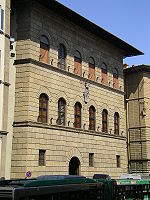San Pancrazio, Florence
EngvarB from May 2013Former Roman Catholic church buildingsFormer churches in FlorenceInfobox religious building with unknown affiliationPages containing links to subscription-only content ... and 1 more
Use list-defined references from May 2013

San Pancrazio is a church in Florence, Italy, in Piazza San Pancrazio, behind Palazzo Rucellai. With the exception of the Rucellai Chapel, it is deconsecrated and is home to the museum dedicated to the sculptor Marino Marini. The Rucellai Chapel contains the Rucellai Sepulchre or Tempietto del Santo Sepolcro. Since February 2013 it has been possible to visit the chapel from within the Marini museum.
Excerpt from the Wikipedia article San Pancrazio, Florence (License: CC BY-SA 3.0, Authors, Images).San Pancrazio, Florence
Via della Spada, Florence Quartiere 1
Geographical coordinates (GPS) Address External links Nearby Places Show on map
Geographical coordinates (GPS)
| Latitude | Longitude |
|---|---|
| N 43.771836111111 ° | E 11.249975 ° |
Address
ex Chiesa di San Pancrazio
Via della Spada
50123 Florence, Quartiere 1
Tuscany, Italy
Open on Google Maps







